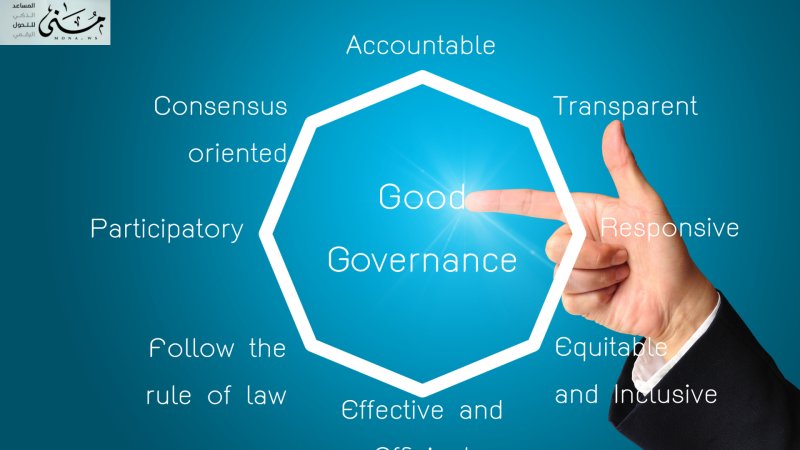Nonprofit governance is essential to ensuring transparency, efficiently achieving community goals, and enhancing the trust of donors and beneficiaries.
Continue reading the article to learn more about nonprofit governance.
What is nonprofit governance?
Nonprofit governance is defined as the framework that defines how an organization is managed and monitored to ensure its sustainability and success. It includes a set of policies and procedures that aim to enhance transparency, accountability, and efficiency in work.
Good nonprofit governance relies on a clear division of roles between managers and beneficiaries, and ensuring that strategic decisions are made that are consistent with its mission and goals.
The importance of governance for non-profit organizations
Governance is a fundamental pillar for achieving transparency and fairness in financial and administrative dealings within non-profit organizations. These systems help enhance the confidence of donors and beneficiaries of the organization’s services, and also contribute to improving its ability to adapt to environmental and economic changes.
By adopting effective nonprofit governance, nonprofit organizations can sustainably achieve their goals and increase their social impact.
Essential Elements of Nonprofit Governance
There are several basic elements related to the governance of non-profit organizations, which are:
Clear administrative and organizational structure
One of the most important elements of nonprofit governance is having a clear management structure that includes defining responsibilities among individuals within the organization. For example, each member of the board of directors should have a specific role and there should be a mechanism for evaluating performance periodically. This helps to enhance accountability and ensure that everyone is working in the same direction to achieve the organization’s goals.
Transparency and financial disclosure
It is essential for non-profit organizations to be transparent in their financial operations and provide accurate and clear reports to beneficiaries and supporters. Having a strong accounting system helps achieve this, and annual financial reports should be published that show how funds are being used and how set goals are being achieved.
Having clear governance policies
A nonprofit organization should have a set of policies and procedures that define how important decisions are made, such as hiring policy, partnership policy, and strategic decision-making mechanism. These policies help prevent chaos and ensure that all decisions are in line with its mission and goals.
Best Practices in Nonprofit Governance
There are several prominent practices in the governance of non-profit organizations, including:
Embrace transparency in all processes.
A best practice in nonprofit governance is to ensure transparency in all aspects of the business, including financial reporting, fundraising campaigns, and the use of funds.
Provide ongoing training for employees
Training employees on nonprofit governance policies is a best practice that ensures they understand the systems and procedures followed in the organization. Ongoing training contributes to improved performance and ensures that policies are implemented correctly.
Monitor performance periodically
Regular reviews and internal assessments help identify problems early and take corrective action, this is an essential part of any successful governance system.
Governance of non-profit organizations is the foundation for the success and sustainability of the organization in achieving its social and humanitarian goals. By adopting an effective governance system, organizations can enhance transparency and accountability, thus improving their impact on society.
Key Challenges in Nonprofit Governance
Despite the importance of governance of non-profit organizations, its implementation on the ground faces several challenges, including the following:
Lack of financial and administrative resources
Nonprofit organizations often rely on donations and grants as the primary source of funding for their activities, which leaves them financially unstable. This lack of resources affects their ability to invest in nonprofit governance systems.
Resistance to change
Organizations often face resistance from board members or employees when trying to introduce new governance procedures, especially if the organization is accustomed to traditional management methods. This resistance can disrupt reform processes and lead to slow implementation of modern governance practices.
Lack of a culture of transparency and accountability
In some cases, the work culture within the organization is not supportive of the concepts of transparency and accountability. Some leaders may consider the publication of financial or administrative information to be a threat to their position or the stability of the organization.
Lack of training and experience
Nonprofit board members are often volunteers, may not have specialized management or governance expertise, and staff may not have adequate training to understand nonprofit governance policies and procedures.
Lack of monitoring and evaluation mechanisms
Even if governance policies and procedures are in place, there may be no mechanisms for periodic follow-up and performance measurement. The lack of effective oversight renders these policies merely inactive texts, and thus the primary objective of governance is not achieved.
Global systems that can be adopted in the governance of non-profit organizations
Globally, there are several governance frameworks and systems specifically designed to guide the work of non-profit organizations, the most prominent of which are:
UK Charity Governance Framework (Charity Governance Code)
This framework is one of the most prominent references in the governance of charitable work, and includes 7 main principles:
- Effective leadership.
- Transparency and accountability.
- Make informed decisions.
- Risk management.
- Diversity of competencies.
- Performance evaluation.
Organizations that rely on this framework ensure that donor and community confidence is built, and it focuses on enabling the board to play its role effectively.
International accountability standards (International NGO Accountability Charter)
These standards were developed by a group of leading non-governmental organizations, and aim to achieve:
- Transparency in financial operations.
- Involving the community in the decision-making process.
- Commitment to human rights.
- Sustainable environmental practices.
- Anti-corruption.
Organizations that adhere to these standards gain international recognition, which increases their credibility with donors.
systemISO 37000:2021 Governance Guidelines
This standard was issued by the International Organization for Standardization (ISO).ISO), which provides general guidance on the governance of non-profit, for-profit and other organizations. The system focuses on:
- Define roles and responsibilities.
- Promote transparency.
- Risk management.
- Support long-term sustainability.
Adopting this standard ensures that governance practices are implemented in accordance with international standards, which increases the organization’s efficiency.
systemGuideStar for Financial Transparency
This system is widely used in the United States and rates nonprofits based on transparency and financial disclosure.GuideStar gives donors a clear picture of an organization’s credibility. The system is based on:
- Publish financial reports periodically.
- Providing data on the organization's activities and achievements.
- Clarification of funding sources.
Doc Suite System
One of the systems that non-profit organizations can adopt is DocSuite. This system enhances the governance of operations within the organization by adopting electronic document management, which contributes to accelerating decision-making processes and enhancing transparency.
DocSuite provides tools to organize administrative communications and automate procedures, making it easier for organizations to handle data and transactions more efficiently and securely.
systemGovernance as Leadership Framework
It is a framework that encourages nonprofit organizations to integrate three key roles into the board of directors:
- Supervisory roleOversight Role: Monitoring financial and administrative performance.
- Advisory role (Advisory Role: Providing strategic guidance.
- Creative role (Generative Role: Participate in creating new solutions.
This framework helps organizations develop boards that are more responsive to challenges, enhancing governance effectiveness.
Comparison of Non-Profit Governance and For-Profit Corporate Governance
Although governance is a common element in both nonprofit organizations and for-profit companies, there are fundamental differences between them, making the implementation of governance practices in each type require different approaches.
Below is a comprehensive comparison that highlights the most important differences between the governance of non-profit organizations and the governance of for-profit companies:
|
Comparison Point |
Non-profit Governance |
Corporate Governance |
|
Main objective |
Achieving public benefit and serving the community. |
Achieving profit and maximizing returns for shareholders. |
|
Funding sources |
Donations, gifts, grants, and government assistance. |
Venture capital, earnings, debt. |
|
Key stakeholders |
Donors, beneficiaries, and the community. |
Shareholders, investors, and customers. |
|
Accountability and Transparency |
Focus on transparency with donors and the public, and publish financial and achievement reports. |
Focus on periodic financial disclosure and financial performance reports to shareholders. |
|
Profits and surpluses |
Any surpluses are reinvested in achieving social goals. |
Profits are distributed to shareholders or reinvested to increase profitability. |
|
Internal control |
Boards of directors are often volunteer, and may sometimes lack financial and administrative expertise. |
Professional boards of directors with high financial and legal expertise. |
|
Challenges |
Limited resources, poor management expertise, financial instability. |
Market competition, shareholder pressure to make profits. |
|
Regulations and laws |
Subject to special laws for charitable associations and institutions. |
Subject to company regulations, such as the Saudi Companies Law. |
|
The technology used |
It is gradually relying on e-governance systems to overcome the shortage of cadres, such as the systemDocSuite. |
ERP systems are used.ERP and advanced e-governance systems. |
Clarifying these differences helps decision-makers in nonprofit organizations draw inspiration from some of the practices of the for-profit sector, such as adopting advanced accounting systems, or strengthening internal controls, while taking into account the different nature of charitable work.
In the face of increasing challenges, nonprofit governance is no longer an option but a necessity to ensure efficiency and sustainability. With the availability of advanced systems such asDocSuite enables these organizations to improve their management, enhance transparency, and keep up with global best practices, helping them achieve their mission in the best possible way.
 اضمن اتخاذ قرارات استراتيجية دقيقة مع حوكمة المنظمات غير الربحية
اضمن اتخاذ قرارات استراتيجية دقيقة مع حوكمة المنظمات غير الربحية












Comments
Add New Comment